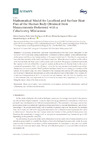Identificador persistente para citar o vincular este elemento:
https://accedacris.ulpgc.es/jspui/handle/10553/35330
| Título: | Mathematical model for localised and surface heat flux of the human body obtained from measurements performed with a calorimetry minisensor | Autores/as: | Socorro, Fabiola Rodríguez de Rivera, Pedro Jesús Rodríguez de Rivera, Miriam de Rivera, Manuel Rodríguez |
Clasificación UNESCO: | 22 Física 221302 Física de la transmisión del calor |
Palabras clave: | Direct calorimetry Heat conduction calorimeters Isothermal calorimeters Medical calorimetry Non-differential calorimeters |
Fecha de publicación: | 2017 | Publicación seriada: | Sensors | Resumen: | The accuracy of the direct and local measurements of the heat power dissipated by the surface of the human body, using a calorimetry minisensor, is directly related to the calibration rigor of the sensor and the correct interpretation of the experimental results. For this, it is necessary to know the characteristics of the body’s local heat dissipation. When the sensor is placed on the surface of the human body, the body reacts until a steady state is reached. We propose a mathematical model that represents the rate of heat flow at a given location on the surface of a human body by the sum of a series of exponentials: W(t) = A0 + åAiexp(t/ti). In this way, transient and steady states of heat dissipation can be interpreted. This hypothesis has been tested by simulating the operation of the sensor. At the steady state, the power detected in the measurement area (4 cm2) varies depending on the sensor’s thermostat temperature, as well as the physical state of the subject. For instance, for a thermostat temperature of 24 C, this power can vary between 100–250 mW in a healthy adult. In the transient state, two exponentials are sufficient to represent this dissipation, with 3 and 70 s being the mean values of its time constants. | URI: | https://accedacris.ulpgc.es/handle/10553/35330 | ISSN: | 1424-8220 | DOI: | 10.3390/s17122749 | Fuente: | Sensors (Switzerland)[ISSN 1424-8220],v. 17 (2749) |
| Colección: | Artículos |
Citas SCOPUSTM
8
actualizado el 08-jun-2025
Citas de WEB OF SCIENCETM
Citations
8
actualizado el 08-jun-2025
Visitas
120
actualizado el 17-feb-2024
Descargas
155
actualizado el 17-feb-2024
Google ScholarTM
Verifica
Altmetric
Comparte
Exporta metadatos
Los elementos en ULPGC accedaCRIS están protegidos por derechos de autor con todos los derechos reservados, a menos que se indique lo contrario.
